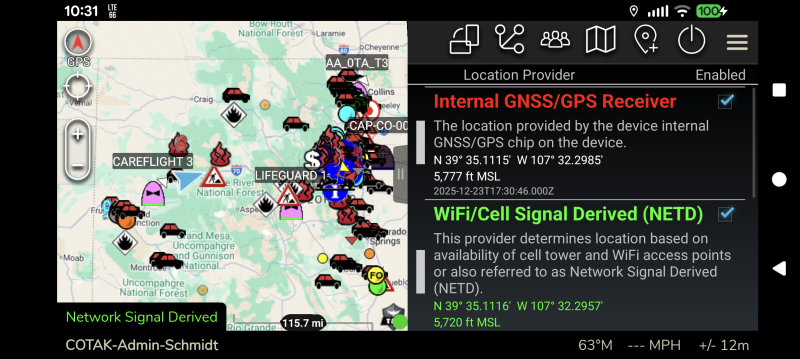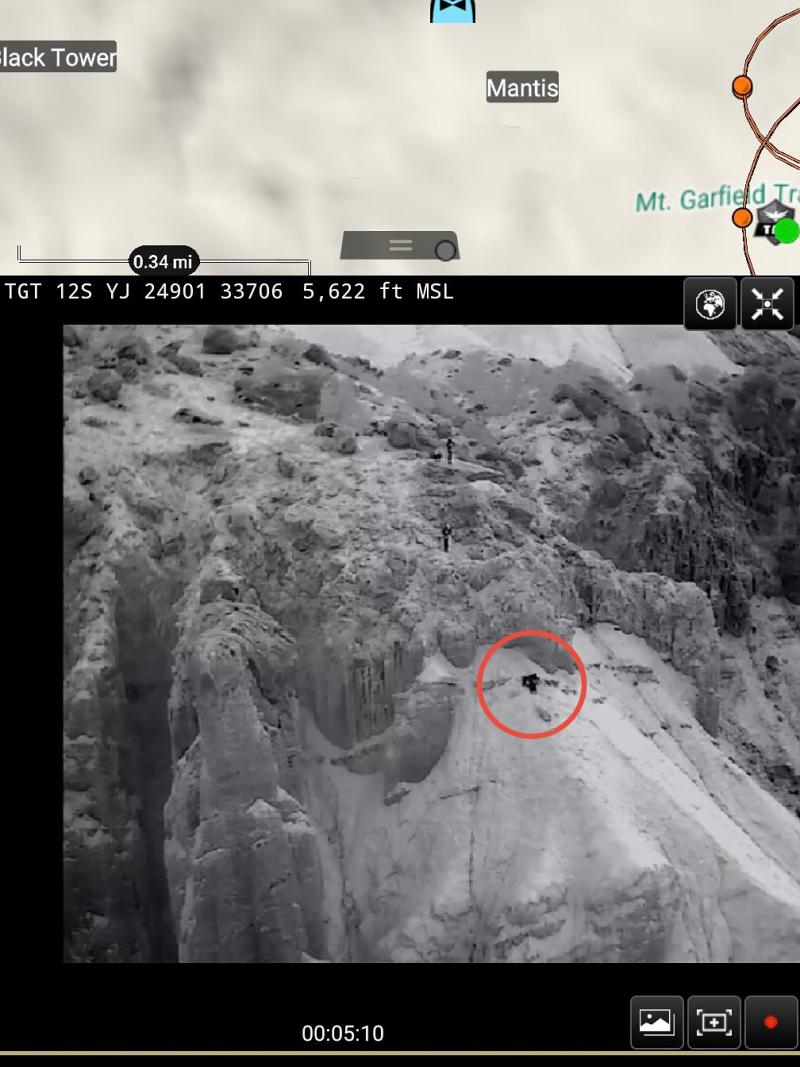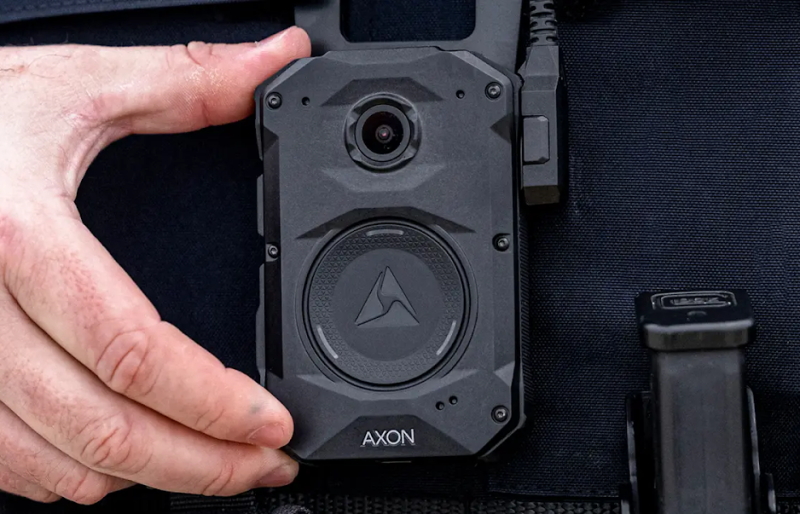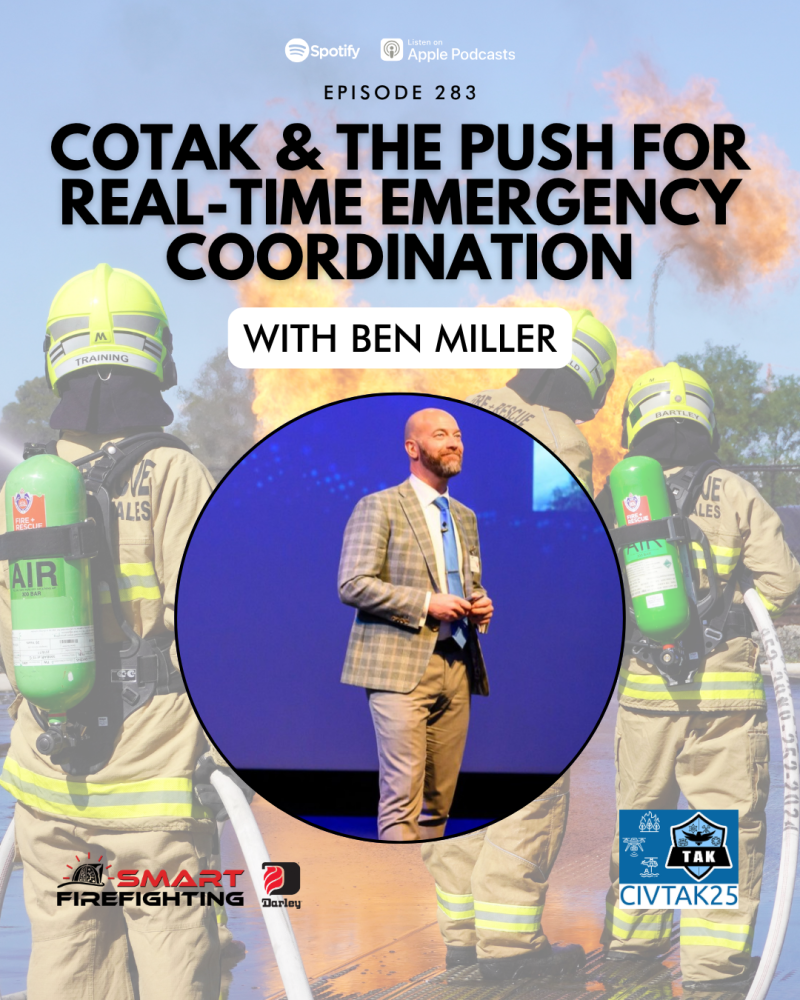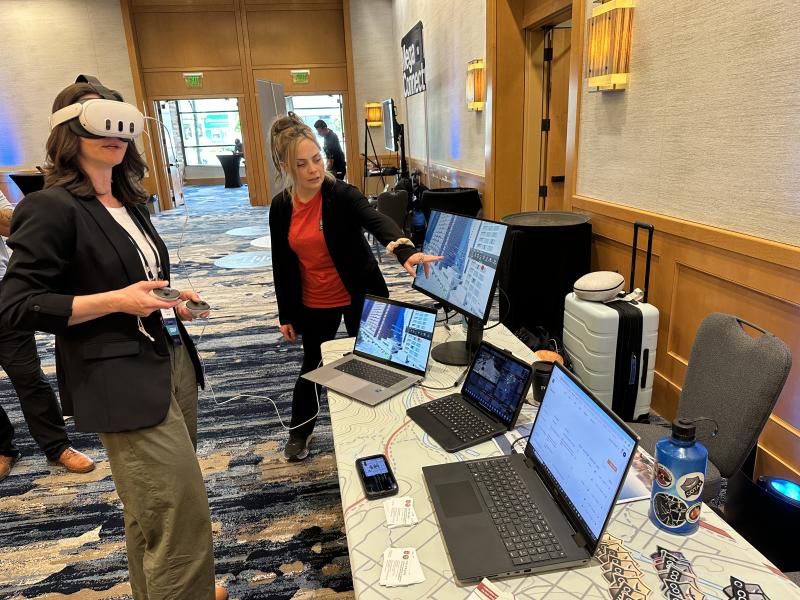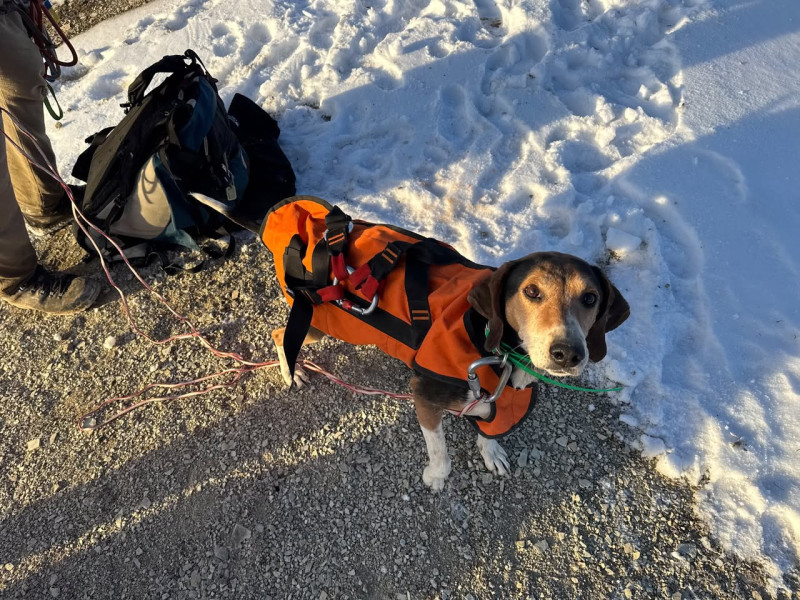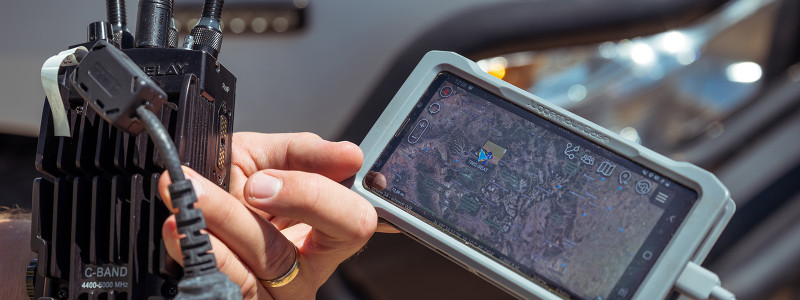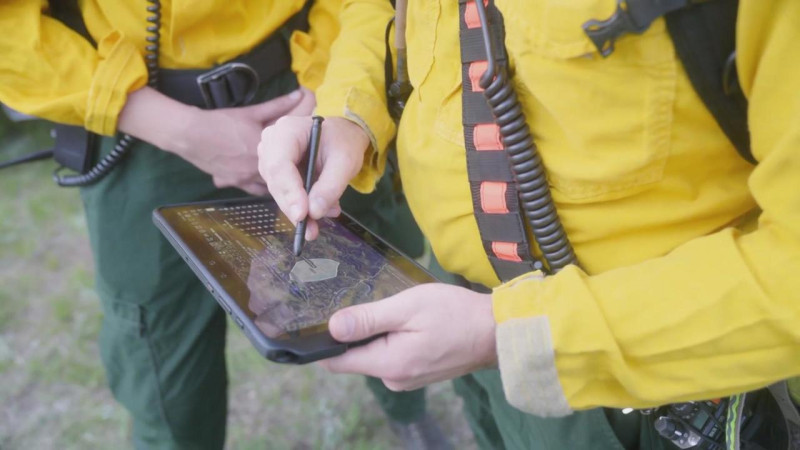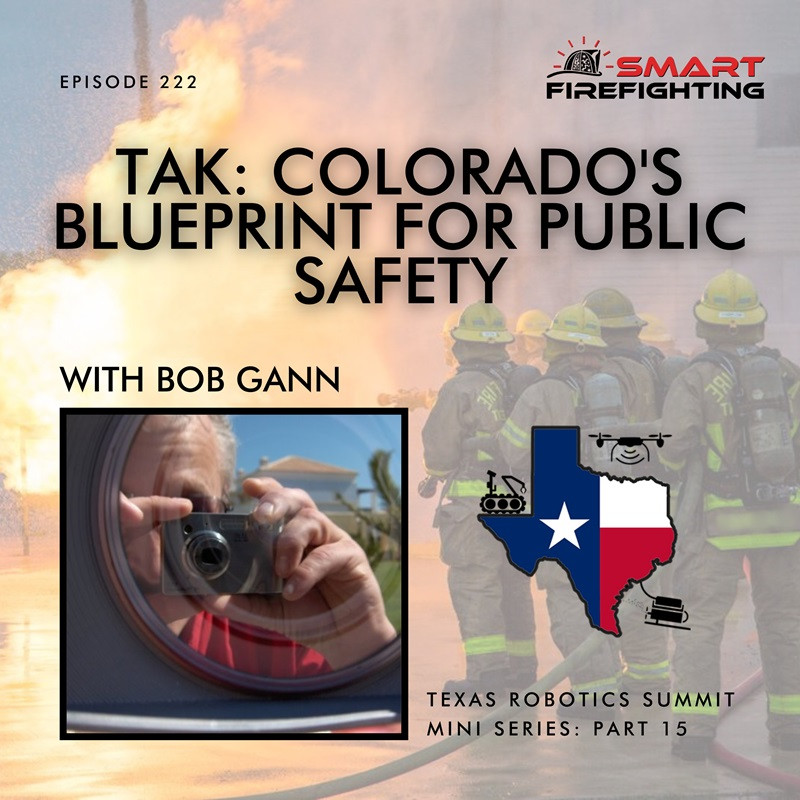News
For Media Inquiries please fill out this form.
ATAK Indoor Location Enhancements
The Android version of TAK (ATAK) has been updated to version 5.6 in the Play Store. As part of this update ATAK now has the ability to use Google’s location services to locate you, in addition to the device’s internal GPS chip. Activating this feature will improve ATAK’s ability to locate you inside buildings or dense urban areas where GPS signals are degraded. Note that iTAK has an equivalent capability enabled by default, so iTAK users do not need to take any action!
Due to ATAK’s extensive use in the military this feature is not enabled by default. To turn it on users should open ATAK, then tap on the three stacked lines in the top right corner of the app to open the tool list, then tap on “Overlays.” In the Overlay Manager that appears scroll toward the bottom of the list and tap on the “Location Input Manager.”
In this new tool is a list of the possible sources of location data for ATAK. The “WiFi/Cell Signal Derived (NETD)” option is new, and may be checked on to improve ATAK’s location accuracy, as it uses Google’s location services to improve your positioning similar to many other smartphone apps.
Users should leave the “Internal GNSS/GPS Receiver” option checked as well, as this allows the app to use both types of technologies to locate you as accurately as possible. When these settings are applied and GPS is lost, ATAK will begin relying on the network signal to locate you, and a special message will appear in the bottom left corner of the app (see attached screenshot). Note that the bottom options in this tool refer to military GPS units and may be left unchecked.
Save the Date for the 2026 COTAK Summit
The COTAK Program Team invites you to save the date for the 2026 COTAK Summit, scheduled for Tuesday, July 7, 2026, through Thursday, July 9, 2026.
The event will take place at the Copper Mountain Conference Center, located in the heart of Copper Mountain Center Village at 184 Copper Circle, Frisco, CO 80443.
At the COTAK Summit, you can expect to gain hands-on experience with the latest COTAK tools, hear real-world success stories from champion agencies, and connect with leaders driving innovation in public safety. With live demonstrations, training sessions, and networking opportunities, this event offers a unique chance to learn and collaborate, paving the way for a stronger future in public safety.
Registration for the COTAK Summit will open in January 2026, and we will accept registrations from 250 guests on a first-come, first-served basis. Once we reach this capacity, sign-ups for the event will close. Be sure to mark your calendars for January 2026 to secure your spot!
In Spring 2026, the COTAK Program Team will release an agenda outline with more detailed information on breakout sessions and speakers. For now, you can view the latest event details and information on our website at cotak.gov/summit
UAS Tool Training Videos
The COTAK Program team is excited to announce the release of a series of training videos on the Uncrewed Aerial Systems (UAS) tool. The UAS tool is a free plugin for the Android version of TAK (ATAK) that enables you to fly many common drones using ATAK and share information on the real-time location of the drone and even its camera stream with other COTAK users.
Part one of the training covers the installation of ATAK and the UAS tool software on a drone controller (or smartphone), and the process of configuring a drone and flying it using the UAS Tool.
Part two of the training covers the process of live streaming the drone’s video to other COTAK users. The COTAK team offers a live video server which routes the drone’s video stream to other users with minimal lag, and this video details how drone pilots can create a new stream using the CloudTAK user interface, how to enter stream information into the UAS Tool, and how to initiate a live stream.
As always, our team is here to support you. If you need further assistance with UAS Tool or other drone integrations, please submit a support ticket, and one of our team members will be happy to assist you.
Mesa County Search and Rescue Successfully Rescued a Climber Using COTAK's Uncrewed Aerial Systems Integration
Story courtesy of Mesa County Search and Rescue
On Saturday, Sept 20, at approximately 8:00 PM, Mesa County Search and Rescue was paged for a subject who became cliffed out while on Mt. Garfield. The subject reported no injuries but was unable to safely descend on their own.
Team members and a UAV were deployed. With new technology, the drone broadcast a live video feed to all team members through COTAK (a navigation & situational awareness app), giving them real-time visuals of the subject’s position and the surrounding terrain. The subject was located just below a 20–30 foot vertical rock face on steep, unstable terrain. Due to significant rockfall risks and poor anchor options, a top-down rescue was deemed hazardous.
A bottom-up approach was initiated and contact with the subject was made at approximately 12:00 AM. The subject was given a harness and helmet and carefully guided to safety using a combination of short roping & short pitching. This approach provided the added protection of a rope belay while navigating the terrain. All team members and the subject safely exited the field by 1:00 AM.
Axon Body Camera Location Integration Now Available
COTAK now has the ability to display the near real-time locations of Axon body cameras! This integration allows COTAK users on your agency’s channel(s) to see the location and the callsign associated with the camera on the map in any of the TAK apps. This integration does not provide live video from the camera, and is configurable to include the location of your officers whenever their camera is turned on, or to only include the location when the camera has been set in recording mode.
Like all COTAK integrations, Axon is offered free-of-charge to COTAK member agencies, though you will need to provide us with a key to your existing Axon account for our staff to set up the integration. Your agency administrator for Axon may follow the directions here to pull the needed information to set up the integration, which they can provide to the COTAK support team by filing a ticket to request the integration at cotak.gov/support.
COTAK Featured in Smart Firefighting Podcast
CoE Director Ben Miller recently had the opportunity to be interviewed on the Smart Firefighting podcast. In the podcast, he discusses strategies for facilitating technology adoption and improving infrastructure for public safety agencies, among other topics. You can listen to it on all popular platforms including Apple Podcasts and Spotify or CLICK HERE to listen now!
Smart Firefighting is a podcast covering technologists, innovators, companies, and forward-thinking public safety agencies with real-world deployments of smart tech.
COTAK Attends 5x5 FirstNet Conference in Seattle
Last week, CoE staff members Adrien Hoff and Brad Schmidt attended the 5x5 FirstNet conference in Seattle.
Throughout the week, staff had the opportunity to learn about cutting-edge public safety technologies and network with experts from around the world. We presented on COTAK and demonstrated it to attendees, including the virtual reality TAK client, VR TAK.
Center of Excellence Delivers Donuts to Rifle PD with Robotic Dog and Drone to Celebrate National Donut Day
RIFLE, COLO. — (June 6, 2025) — The Center of Excellence for Advanced Technology Aerial Firefighting (CoE) collaborated with the Rifle Police Department (RPD) to celebrate National Donut Day in a unique manner. To commemorate this sweet occasion, the CoE employed a robotic dog named Lucky to deliver donuts to the RPD using a drone.
This creative demonstration highlights the importance of advanced technologies in the public safety sector while providing a delightful treat. Lucky was equipped with a specially designed 3D-printed harness that allowed him to carry the donuts. With more than a dozen glazed donuts secured on his back, Lucky successfully delivered the treats to the officers on duty at the Rifle Police Department.
"Our passion is to leverage technology to discover new and improved methods for enhancing all aspects of the public safety industry. As technology continuously evolves, we are excited to show how it can positively impact public safety efforts in a sweet and engaging way," said Dana Way, Marketing and Communications Manager at the Center of Excellence for Advanced Technology Aerial Firefighting. "Today, we have combined advanced technology with National Donut Day to highlight how innovation is shaping the future of public safety and to collaborate on a project that improves all of our skills."
Rifle Police Department is taking the lead in utilizing advanced technologies, such as drones, for public safety operations. Drones, robotic technologies, and other cutting-edge systems are becoming increasingly vital for providing real-time situational awareness, enhancing public safety efforts, and assisting emergency responders in complex situations.
"The use of drones has become an essential part of our operations with the recent formation of our drone team. This collaboration playfully illustrates how technology can be used in innovative ways to support our officers and the community," said Lieutenant Mike Kuper at the Rifle Police Department. "We’ve already put the drone to work locating missing people, documenting and mapping crime scenes, and enhancing safety and situational awareness during parade routes. We’re proud to be at the forefront of this technology and to utilize it in ways that improve both safety and efficiency in our officers."
This joint initiative marks just the beginning of what is possible when public safety agencies embrace advanced technology. The Center of Excellence continues to support and develop cutting-edge systems that can enhance public safety operations across Colorado and beyond. To watch Lucky deliver donuts to the Rifle Police Department, follow the Center of Excellence on Facebook, Instagram, LinkedIn, and YouTube.
# # #
About the Center of Excellence
Formed in 2014, the Center of Excellence for Advanced Technology Aerial Firefighting is a research and development organization within the Colorado Division of Fire Prevention and Control, part of the Colorado Department of Public Safety. The Center of Excellence is dedicated to driving technological advancements to improve emergency response practices and influence innovation across public safety for the communities they serve. For more information, visit cofiretech.org or follow us on Facebook, Instagram, X, YouTube, and LinkedIn.
About the Rifle Police Department
The Rifle Police Department is committed to protecting and serving the citizens of Rifle, Colorado, with professionalism, integrity, and compassion. Through proactive community engagement, innovative policing strategies, and a dedication to public safety, RPD builds strong partnerships and enhances the quality of life for all who live, work, and visit our city. For more information, visit rifleco.org or follow us on Facebook.
Media Contacts:
Center of Excellence for Advanced Technology Aerial Firefighting
Dana Way
Marketing and Communications Manager
C: (303) 217-0062
Rifle Police Department
Angela Mills
Public Information Officer
D: (970) 665-6500
C: (970) 852-1226
Interagency Channels
A new tool is now available in COTAK allowing multiple agencies to share their user’s locations and interoperate! This tool, called interagency channels, allows you as an agency administrator to invite other agencies to join your users on a common channel for interoperability. This option is in addition to traditional mutual aid channels that are permanently created by the COTAK program team for use by agencies within a county or region.
Interagency channels in COTAK works similarly to the patching of voice radio channels, but differs in that COTAK creates a new interagency channel for the patch using the membership of multiple ‘normal’ channels. To learn more about this exciting new feature watch our training video here. If you would like assistance setting up interagency channels contact our support team at cotak.gov/support.
Introducing CDOT Cameras
Live roadside video camera feeds from CDOT are now available for all TAK apps, including iTAK! With nearly 700 cameras covering interstates and major highways across Colorado, this capability allows COTAK users to gain unique situational awareness on weather conditions and traffic incidents and can be selectively enabled or hidden in the apps. Follow the instructions to download the package containing the camera feeds.
COTAK Aided MCSAR in Rescuing a Four-Legged Friend
On January 2, 2025, the Mesa County Search & Rescue (MCSAR) team received a call to rescue a trapped dog near Collbran, CO. This rescue was unique and challenging because the dog, named Tiny, was stuck on a mountainside with rugged and elevated terrain. Thanks to the Colorado Team Awareness Kit (COTAK), the MCSAR team was able to pinpoint Tiny's location, plan their rescue operations, and ensure the safe return of both Tiny and the responders.
As daylight faded after a six-hour rescue mission, the responders utilized COTAK to identify a safe route back to the mountain base. They successfully reunited Tiny with her owners around 10 p.m., marking a successful collaboration with Mesa County Search and Rescue and COTAK.
This story illustrates that COTAK is truly a life-saving solution for both emergency responders and our furry friends. Continue reading below for the full press release from MCSAR.
___________
Around 9 a.m. on January 2, 2025, Mesa County Search and Rescue (MCSAR) received a call to rescue a trapped tracking dog near Collbran, CO. The owners of the dog, named Tiny, advised MCSAR that Tiny had been tracking a mountain lion when she became stranded in the middle of a cliff face near the mountain’s summit 24 hours prior. Thanks to a GPS tracker on Tiny’s collar, the owners knew her approximate location, though realized it wasn’t somewhere they could safely reach her.
With Tiny’s approximate location known, the MCSAR team planned their rescue operations using the Colorado Team Awareness Kit (COTAK) to safely rescue her from the mountainside. However, the team quickly encountered challenging terrain, which slowed progress significantly. After some consideration, the MCSAR operations team determined that splitting the group into two teams would be more effective in finding a route through the many cliff bands that had halted progress toward Tiny’s location. A hasty team of three members, deemed Team 1, was sent to the east to try to find a break in the cliffs, while the larger group, deemed Team 2, attempted to find a gap to the west.
Over the next six hours, Team 1 carefully rappelled and climbed through the cliff bands, working toward the ridge top. They ascended several thousand feet from there before finally reaching the peak where Tiny had become trapped. After confirming Tiny’s location below, the team built a system to lower a rescuer down and retrieve her using a harness designed for dog rescue in technical terrain. At approximately 4 p.m., Tiny was raised back to the mountain's summit.
The celebration of Tiny's rescue from the cliff face was short-lived, however, as Team 1 had a new challenge: finding a safe route back to the mountain's base in diminishing light. Back at the base of the mountain, MCSAR operations team members were able to map out a different route in COTAK for Team 1 to follow. This new route took Team 1 across the other side of the mountain through snow-covered terrain, including multiple waterfalls that they rappelled off of with Tiny in tow. Due to Tiny’s diminished physical condition, Team 1 carried the dog for much of the trip.
As Team 1 descended the mountain, MCSAR moved their staging location to the north side to gain better access to Team 1. Once relocated, Team 2 made their way up the mountain on horses provided and led by Tiny’s owner. They brought essential supplies - water and food - to replenish Team 1. Once the two groups united, the MCSAR members swapped places, giving Team 1 a much-needed break as they rode the horses the rest of the way down the mountain.
Tiny was reunited with her very thankful owners around 10 p.m., marking the end of a successful rescue mission. Every mission matters for Mesa County Search and Rescue, even if it’s Tiny.
Press release courtesy of Mesa County Search and Rescue
Announcing the iTAK Breadcrumb Tool
The COTAK program has begun to directly fund the development of the iOS version of TAK, known as iTAK. The first COTAK-funded feature for iTAK has been released. This feature is a breadcrumb tool that allows a user to optionally track any map marker, including their own, as it moves across the map. When engaged, this feature leaves a trail of breadcrumbs behind as the marker moves, allowing users to establish the direction of travel and a marker’s previous locations. This trail can be exported as a route or can be converted into a shape. Learn more about this feature by watching our training video.
COTAK – Colorado’s Wildfire Technology Game Changer
The COTAK team recently met with Aerial Fire Magazine to discuss how we are providing real time information to wildland firefighters and other first responders.
High-tech app developers hope to save lives and property in Colorado wildfires and other disasters
CBS 4 Denver featured the COTAK program in a story describing its development and how it is being used to improve the situational awareness of first responders.
COTAK Featured on Podcast
CoE Deputy Director of Science and Research Dr. Bob Gann was recently featured on the “Smart Firefighting” podcast with a discussion on COTAK. Bob has been instrumental in building the cotak.gov website and user management system, and in this podcast he shares his insight on why COTAK was built and what our value proposition is to first responders in Colorado. If you have 20 minutes to spare the podcast episode is well worth a listen!
COTAK User Forum Live
A user forum has been added to the COTAK website. Any user with a valid COTAK login can access the forum at forum.cotak.gov and logging in with the same username and password used by your main COTAK account. The forum allows first responders using COTAK to ask questions and receive support from other first responders using COTAK and the COTAK project team. The forum also serves as a central location for first responders to learn about how others are using COTAK and exchange ideas.
